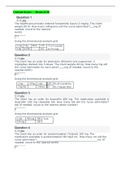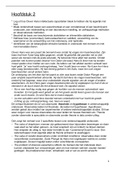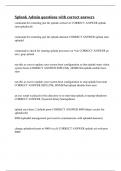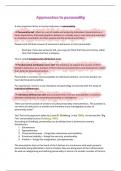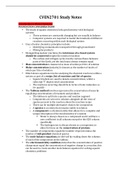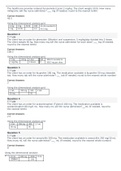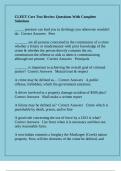Nudge: Influencing Behaviour Article Summaries
Table of Contents
PART I – Nudging ..............................................................................................................2
Article 1 | Motta, M., Callaghan, T., & Sylvester, S. (2018). Knowing less but presuming more:
Dunning-Kruger effects and the endorsement of anti-vaccine policy attitudes. Social Science &
Medicine, 211, 274-281 .......................................................................................................................2
Article 2 | Goldstein, D. G., Johnson, E. J., Herrmann, A., & Heitmann, M. (2008). Nudge your
customers toward better choices. Harvard Business Review, 86(12), 99-105. ..................................2
Article 3 | Ly, K., Mažar, N., Zhao, M., & Soman, D. (2013). A practitioner’s guide to nudging. ........4
Article 4 | Van der Wal, A. J., Schade, H. M., Krabbendam, L., & Van Vugt, M. (2013). Do natural
landscapes reduce future discounting in humans? Proceedings of the Royal Society of London B:
Biological Sciences, 280(1773), 20132295. .........................................................................................6
Article 5 | Dirkmaat & Steeg (2018). A wealth of behavioural insights: Edition 2019 .......................6
Article 6 | Schmidt, AT, Engelen, B. (2020). The ethics of nudging: An overview. Philosophy
Compass, 15(4), e12658. .....................................................................................................................7
Article 7 |Cadario, R., & Chandon, P. (2020). Which healthy eating nudges work best? A meta-
analysis of field experiments. Marketing Science, 39(3), 465-486. ....................................................9
PART II – Social Influence ................................................................................................10
Article 8 | Van Herpen, E., Pieters, R., & Zeelenberg, M. (2009). When demand accelerates
demand: Trailing the bandwagon. Journal of Consumer Psychology, 19(3), 302-312. ....................10
Article 9 | Keizer, K., Lindenberg, S., & Steg, L. (2008). The spreading of disorder. Science, 322,
1681-1685..........................................................................................................................................11
Article 10 | Goldstein, N. J., Cialdini, R. B., & Griskevicius, V. (2008). A room with a viewpoint:
Using social norms to motivate environmental conservation in hotels. Journal of consumer
Research, 35(3), 472-482. .................................................................................................................15
Article 11 | Berger, J., & Rand, L. (2008). Shifting signals to help health: Using identity signaling to
reduce risky health behaviors. Journal of Consumer Research, 35(3), 509-518. ..............................16
Article 12 | Small, D. A., Loewenstein, G., & Slovic, P. (2007). Sympathy and callousness: The
impact of deliberative thought on donations to identifiable and statistical victims. Organizational
Behavior and Human Decision Processes, 102(2), 143-153..............................................................17
1
,PART I – Nudging
Article 1 | Motta, M., Callaghan, T., & Sylvester, S. (2018). Knowing less but
presuming more: Dunning-Kruger effects and the endorsement of anti-vaccine policy
attitudes. Social Science & Medicine, 211, 274-281
(Only Introduction and Discussion)
Introduction:
Dunning-Kruger effect = individuals who lack expertise fail to
accurately appraise their own knowledge vis-a-vis experts on
the subject.
Overconfidence = a person’s subjective confidence is greater
than the objective accuracy of those judgements
• Optimism bias (e.g. my marriage will succeed, while
40% of the marriages end in divorce)
Discussion:
Main findings
1. people who know the least about the causes of autism (Hypothesis 1a) and who are
misinformed about the link between vaccines and autism (Hypothesis 1b) are the
most likely to think that they know more than medical professionals about the
causes of autism – a Dunning Kruger effect.
2. this “overconfidence” has important implications for vaccine policy. People who
think that they know more than medical professionals are less supportive of pro-
vaccine policies (Hypothesis 2a) and more likely to elevate the role that non-experts
play in the policymaking process (Hypothesis 2b).
Limitations of study
1. the possibility that overconfidence is simply a “proxy” for low levels of trust in
scientific experts. According to this view, overconfidence occurs not because people
have (erroneously) elevated assessments of their own knowledge, but because they
find experts untrustworthy.
BUT found that most respondents do place at least some amount of trust
in medical experts
2. use of cross-sectional survey data; cannot answer more general questions about the
origins of knowledge and misinformation about autism.
2
, Article 2 | Goldstein, D. G., Johnson, E. J., Herrmann, A., & Heitmann, M. (2008).
Nudge your customers toward better choices. Harvard Business Review, 86(12), 99-
105.
Choice architecture = the design of environments in order to influence decisions
• Defaults are the building blocks of this environment
e.g. opt-out vs opt-in donor registration
Framework of defaults
1. Mass defaults
Apply to all customers without taking individual characteristics or preferences into
account
e.g. standard shipping
a. Hidden option
Presents a single option (default) as the customer’s only choice when
alternatives do exist but have to be looked for
e.g. apps with default sound or colour
b. Benign defaults
Represents a company’s best guess about which option would be most
acceptable and present the least risk
e.g. maxi-cosi in new-born configuration
c. Forced choice
Requires would-be customers to make active choices or be denied access to
product or service
e.g. when choosing ‘not least risk’ option as default
d. Random defaults
To figure out customers preferences
2. Personalized defaults
Reflect individual differences and can be tailored to better meet customer’s needs
a. Persistent defaults
Assume that a customer’s past choices are the best predictor of future
preferences
e.g. smokers; hotels allowed to smoke are pre-selected
BUT annoyance when there’s a preference reversal (e.g. not smoke
anymore)
b. Smart defaults
Use customer information to generate individualized options that are optimal
for both customer and company based on (for example) demographic or
geographic information
e.g. country code based on IP address
c. Adaptive defaults
Dynamically update based on current, often rea;-time decisions that a
customer has made
e.g. suggest premium or budget package to not scare away price
sensitive customers
3
Table of Contents
PART I – Nudging ..............................................................................................................2
Article 1 | Motta, M., Callaghan, T., & Sylvester, S. (2018). Knowing less but presuming more:
Dunning-Kruger effects and the endorsement of anti-vaccine policy attitudes. Social Science &
Medicine, 211, 274-281 .......................................................................................................................2
Article 2 | Goldstein, D. G., Johnson, E. J., Herrmann, A., & Heitmann, M. (2008). Nudge your
customers toward better choices. Harvard Business Review, 86(12), 99-105. ..................................2
Article 3 | Ly, K., Mažar, N., Zhao, M., & Soman, D. (2013). A practitioner’s guide to nudging. ........4
Article 4 | Van der Wal, A. J., Schade, H. M., Krabbendam, L., & Van Vugt, M. (2013). Do natural
landscapes reduce future discounting in humans? Proceedings of the Royal Society of London B:
Biological Sciences, 280(1773), 20132295. .........................................................................................6
Article 5 | Dirkmaat & Steeg (2018). A wealth of behavioural insights: Edition 2019 .......................6
Article 6 | Schmidt, AT, Engelen, B. (2020). The ethics of nudging: An overview. Philosophy
Compass, 15(4), e12658. .....................................................................................................................7
Article 7 |Cadario, R., & Chandon, P. (2020). Which healthy eating nudges work best? A meta-
analysis of field experiments. Marketing Science, 39(3), 465-486. ....................................................9
PART II – Social Influence ................................................................................................10
Article 8 | Van Herpen, E., Pieters, R., & Zeelenberg, M. (2009). When demand accelerates
demand: Trailing the bandwagon. Journal of Consumer Psychology, 19(3), 302-312. ....................10
Article 9 | Keizer, K., Lindenberg, S., & Steg, L. (2008). The spreading of disorder. Science, 322,
1681-1685..........................................................................................................................................11
Article 10 | Goldstein, N. J., Cialdini, R. B., & Griskevicius, V. (2008). A room with a viewpoint:
Using social norms to motivate environmental conservation in hotels. Journal of consumer
Research, 35(3), 472-482. .................................................................................................................15
Article 11 | Berger, J., & Rand, L. (2008). Shifting signals to help health: Using identity signaling to
reduce risky health behaviors. Journal of Consumer Research, 35(3), 509-518. ..............................16
Article 12 | Small, D. A., Loewenstein, G., & Slovic, P. (2007). Sympathy and callousness: The
impact of deliberative thought on donations to identifiable and statistical victims. Organizational
Behavior and Human Decision Processes, 102(2), 143-153..............................................................17
1
,PART I – Nudging
Article 1 | Motta, M., Callaghan, T., & Sylvester, S. (2018). Knowing less but
presuming more: Dunning-Kruger effects and the endorsement of anti-vaccine policy
attitudes. Social Science & Medicine, 211, 274-281
(Only Introduction and Discussion)
Introduction:
Dunning-Kruger effect = individuals who lack expertise fail to
accurately appraise their own knowledge vis-a-vis experts on
the subject.
Overconfidence = a person’s subjective confidence is greater
than the objective accuracy of those judgements
• Optimism bias (e.g. my marriage will succeed, while
40% of the marriages end in divorce)
Discussion:
Main findings
1. people who know the least about the causes of autism (Hypothesis 1a) and who are
misinformed about the link between vaccines and autism (Hypothesis 1b) are the
most likely to think that they know more than medical professionals about the
causes of autism – a Dunning Kruger effect.
2. this “overconfidence” has important implications for vaccine policy. People who
think that they know more than medical professionals are less supportive of pro-
vaccine policies (Hypothesis 2a) and more likely to elevate the role that non-experts
play in the policymaking process (Hypothesis 2b).
Limitations of study
1. the possibility that overconfidence is simply a “proxy” for low levels of trust in
scientific experts. According to this view, overconfidence occurs not because people
have (erroneously) elevated assessments of their own knowledge, but because they
find experts untrustworthy.
BUT found that most respondents do place at least some amount of trust
in medical experts
2. use of cross-sectional survey data; cannot answer more general questions about the
origins of knowledge and misinformation about autism.
2
, Article 2 | Goldstein, D. G., Johnson, E. J., Herrmann, A., & Heitmann, M. (2008).
Nudge your customers toward better choices. Harvard Business Review, 86(12), 99-
105.
Choice architecture = the design of environments in order to influence decisions
• Defaults are the building blocks of this environment
e.g. opt-out vs opt-in donor registration
Framework of defaults
1. Mass defaults
Apply to all customers without taking individual characteristics or preferences into
account
e.g. standard shipping
a. Hidden option
Presents a single option (default) as the customer’s only choice when
alternatives do exist but have to be looked for
e.g. apps with default sound or colour
b. Benign defaults
Represents a company’s best guess about which option would be most
acceptable and present the least risk
e.g. maxi-cosi in new-born configuration
c. Forced choice
Requires would-be customers to make active choices or be denied access to
product or service
e.g. when choosing ‘not least risk’ option as default
d. Random defaults
To figure out customers preferences
2. Personalized defaults
Reflect individual differences and can be tailored to better meet customer’s needs
a. Persistent defaults
Assume that a customer’s past choices are the best predictor of future
preferences
e.g. smokers; hotels allowed to smoke are pre-selected
BUT annoyance when there’s a preference reversal (e.g. not smoke
anymore)
b. Smart defaults
Use customer information to generate individualized options that are optimal
for both customer and company based on (for example) demographic or
geographic information
e.g. country code based on IP address
c. Adaptive defaults
Dynamically update based on current, often rea;-time decisions that a
customer has made
e.g. suggest premium or budget package to not scare away price
sensitive customers
3


